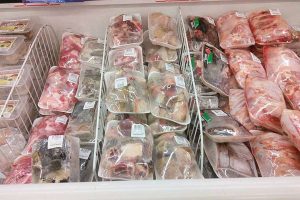THE Meat Importers and Traders Association (MITA) said the price of imported meat could rise due to high international prices and a weak peso.
“We are already seeing the stocks of some major players thinning out,” MITA President Emeritus Jesus C. Cham said via Viber.
The peso closed at P58.295 against the dollar on Wednesday, according to the Bankers Association of the Philippines.
Mr. Cham added that the recent signing of Executive Order (EO) No. 62, which cut import tariffs on major food items, could provide predictably for the meat import market.
“Unless the producers manage to overturn it,” he added.
EO 62, signed by President Ferdinand R. Marcos, Jr. extended low tariffs on pork and mechanically deboned chicken meat until 2028.
The tariff for pork was kept at 15% for shipments within the minimum access volume and 25% for those exceeding the quota. On the other hand, the rate for mechanically deboned chicken was retained at 5%.
According to the Bureau of Animal Industry, meat imports rose 10% during the five months to May, totaling 524.68 million kilograms.
Mr. Cham said shipments of major meats rose year on year despite the delayed release of quotas for pork and chicken.
“While we expect the quota to be finalized this month, only a few months remain to fully utilize,” he added.
He said that the heightened price of domestically grown pork and chicken may have driven consumers to cheaper imported variant.
“This suggests that the high price of local pork and poultry continue to make imported meat competitive and attractive. The high price of domestically grown meat could be attributed to decreased production and higher costs due to the El Niño,” Mr. Cham said.
According to the Department of Agriculture, a kilogram of domestically grown whole chicken in Metro Manila sold for between P190 and P250 per kilogram. On the other hand, pork belly (liempo) sold for between P350 and P410 per kilo, while pork shoulder (kasim) fetched P300-P380 per kilo.
Pork and chicken were the top meat imports during the six months at 253.55 million kilos and 181.23 million kilos, respectively.
Mr. Cham added that due to the rise in prices, beef is also emerging as an alternative.
“The high price of pork and poultry may have narrowed the gap against beef, making it easier to shift consumption from the former to the latter,” he said. — Adrian H. Halili
